Cardiovascular Performance Measurement in Water Fleas by Utilizing High-Speed Videography and ImageJ Software and Its Application for Pesticide Toxicity Assessment
Simple Summary
Abstract
1. Introduction
2. Materials and Methods
2.1. Water Flea Maintenance and Sample Preparation
2.2. The Effect of Temperature Change and Pesticide Exposure on Cardiovascular Performance
2.3. High-Speed Videography
2.4. Cardiovascular Parameter Calculation
2.5. Statistics
3. Results
3.1. Overview of Instrument Settings and Algorithms Used to Conduct the Experiment
3.2. The Illustration of Water Flea Images and Calculation of Cardiovascular Function
3.3. Correlation of Body Size and Cardiovascular Performance in Daphnids
3.4. The Evaluation of the Effect of Temperature Changes on Water Fleas Based on Heartbeat
3.5. Blood Flow Measurement for Different Water Flea Species
3.6. Toxicity Assessment of Pesticide in Water Fleas Based on Heartbeat and Blood Flow
4. Discussion
Supplementary Materials
Author Contributions
Funding
Acknowledgments
Conflicts of Interest
Appendix A
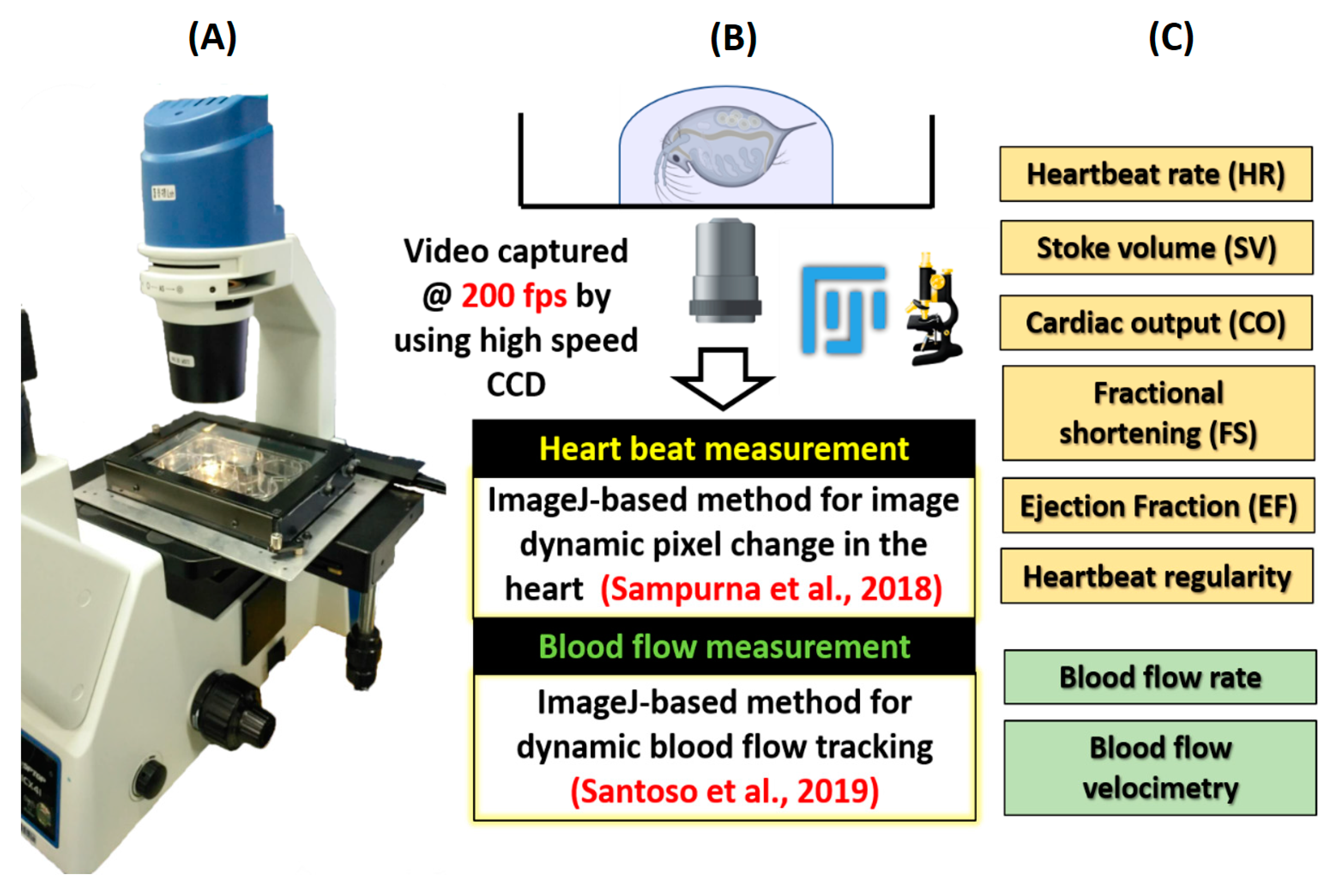
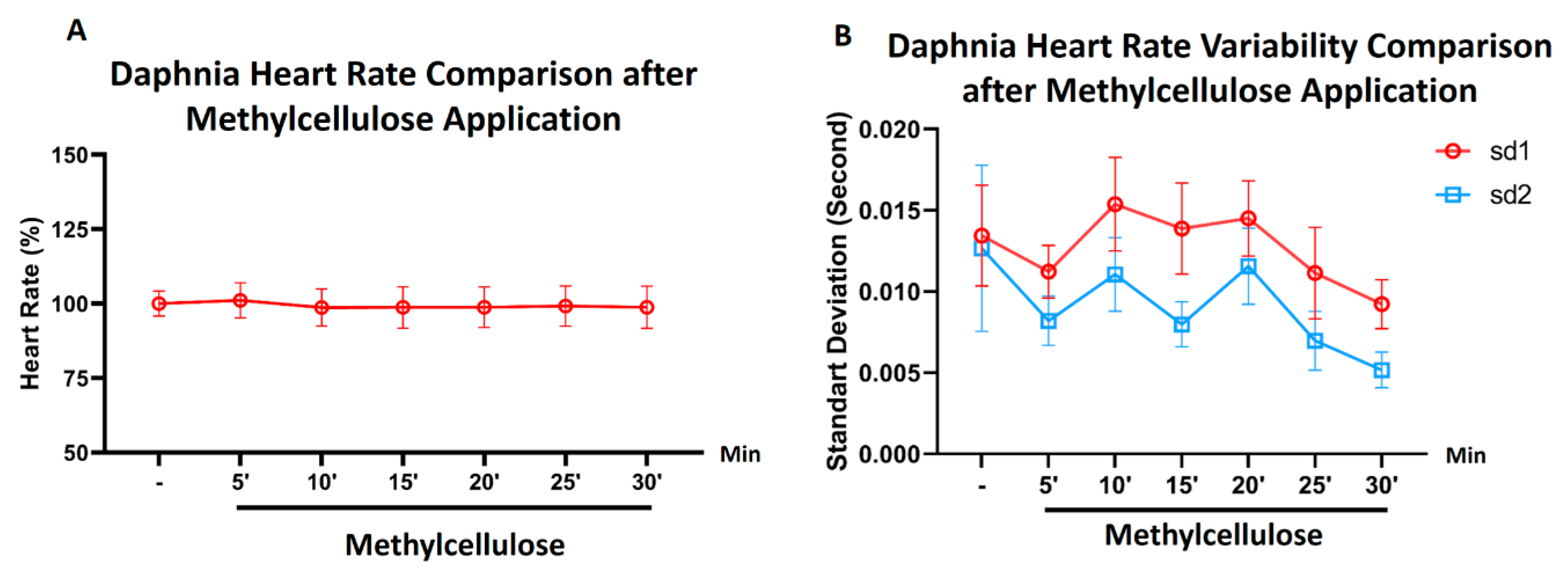
References
- Offem, B.O.; Ayotunde, E.O. Toxicity of lead to freshwater invertebrates (Water fleas; Daphnia magna and Cyclop sp) in fish ponds in a tropical floodplain. Water Air Soil Pollut. 2008, 192, 39–46. [Google Scholar] [CrossRef]
- Kundu, A.; Singh, G. Dopamine synergizes with caffeine to increase the heart rate of Daphnia. F1000Research 2018, 7, 254. [Google Scholar] [CrossRef] [PubMed]
- Chung, W.; Song, J.M.; Lee, J. The Evaluation of Titanium Dioxide Nanoparticle Effects on Cardiac and Swimming Performance of Daphnia magna. Int. J. Appl. Environ. Sci. 2016, 11, 1375–1385. [Google Scholar]
- Jardim, G.M.; Armas, E.D.d.; Monteiro, R.T.R. Ecotoxicological assessment of water and sediment of the Corumbataí River, SP, Brazil. Braz. J. Biol. 2008, 68, 51–59. [Google Scholar] [CrossRef]
- Greene, M.; Pitts, W.; Dewprashad, B. Using Videography to Study the Effects of Stimulants on Daphnia magna. Am. Biol. Teach. 2017, 79, 35–40. [Google Scholar] [CrossRef]
- Molnar, C.; Gair, J. Concepts of Biology: 1st Canadian Edition; BCcampus: Victoria, BC, Canada, 2015. [Google Scholar]
- OECD. Test No. 211: Daphnia Magna Reproduction Test; OECD Publishing: Paris, France, 2012. [Google Scholar]
- Guilhermino, L.; Diamantino, T.; Silva, M.C.; Soares, A. Acute toxicity test with Daphnia magna: An alternative to mammals in the prescreening of chemical toxicity? Ecotoxicol. Environ. Saf. 2000, 46, 357–362. [Google Scholar] [CrossRef]
- Rodgher, S.; Espíndola, E.L.G.; Lombardi, A.T. Suitability of Daphnia similis as an alternative organism in ecotoxicological tests: Implications for metal toxicity. Ecotoxicology 2010, 19, 1027–1033. [Google Scholar] [CrossRef]
- Iwai, C.B.; Somparn, A.; Noller, B. Using zooplankton, Moina micrura Kurz to evaluate the ecotoxicology of pesticides used in paddy fields of Thailand. In Pesticides in the Modern World—Risks and Benefits; INTECH: London UK, 2011; pp. 267–280. [Google Scholar]
- Colbourne, J.K.; Pfrender, M.E.; Gilbert, D.; Thomas, W.K.; Tucker, A.; Oakley, T.H.; Tokishita, S.; Aerts, A.; Arnold, G.J.; Basu, M.K. The ecoresponsive genome of Daphnia pulex. Science 2011, 331, 555–561. [Google Scholar] [CrossRef]
- Gaikwad, N.; Panat, A.; Deshpande, M.; Ramya, K.; Khalid, P.; Augustine, P. Effect of shilajit on the heart of Daphnia: A preliminary study. J. Ayurveda Integr. Med. 2012, 3, 3. [Google Scholar]
- Tyagi, V.; Chopra, A.; Durgapal, N.; Kumar, A. Evaluation of Daphnia magna as an indicator of toxicity and treatment efficacy of municipal sewage treatment plant. J. Appl. Sci. Environ. Manag. 2007, 11. [Google Scholar] [CrossRef]
- Tong, Z.; Huailan, Z.; Hongjun, J. Chronic toxicity of acrylonitrile and acetonitrile to Daphnia magna in 14-d and 21-d toxicity tests. Bull. Environ. Contam. Toxicol. 1996, 57, 655–659. [Google Scholar] [CrossRef] [PubMed]
- Barata, C.; Baird, D.J. Determining the ecotoxicological mode of action of chemicals from measurements made on individuals: Results from instar-based tests with Daphnia magna Straus. Aquat. Toxicol. 2000, 48, 195–209. [Google Scholar] [CrossRef]
- Hanazato, T. Growth analysis of Daphnia early juvenile stages as an alternative method to test the chronic effect of chemicals. Chemosphere 1998, 36, 1903–1909. [Google Scholar] [CrossRef]
- Trubetskova, I.; Lampert, W. The juvenile growth rate of Daphnia: A short-term alternative to measuring the per capita rate of increase in ecotoxicology? Arch. Environ. Contam. Toxicol. 2002, 42, 193–198. [Google Scholar] [PubMed]
- Krylov, V.V. Effects of electromagnetic fields on parthenogenic eggs of Daphnia magna Straus. Ecotoxicol. Environ. Saf. 2010, 73, 62–66. [Google Scholar] [CrossRef] [PubMed]
- Zang, C.; Laia, N.; Gruse, A.; Comfort, C.; Felder, M. Caffeine and acetylcholine decrease Daphnia magna heart rate. J. Undergrad. Biol. Lab. Investig. 2019, 2, 2. [Google Scholar]
- Fekete-Kertész, I.; Stirling, T.; Ullmann, O.; Farkas, É.; Kirchkeszner, C.; Feigl, V.; Molnár, M. How Does Experimental Design Modify the Result of Daphnia magna Heartbeat Rate Test?─Analyses of Factors Affecting the Sensitivity of the Test System. Period. Polytech. Chem. Eng. 2018, 62, 257–264. [Google Scholar] [CrossRef]
- Kaas, B.; Krishnarao, K.; Marion, E.; Stuckey, L.; Kohn, R. Effects of melatonin and ethanol on the heart rate of Daphnia magna. IMPULSE Prem. J. Undergrad. Publ. Neurosci. 2009, 1, 1–8. [Google Scholar]
- Colmorgen, M.; Paul, R.J. Imaging of physiological functions in transparent animals (Agonus cataphractus, Daphnia magna, Pholcus phalangioides) by video microscopy and digital image processing. Comp. Biochem. Physiol. Part A Physiol. 1995, 111, 583–595. [Google Scholar] [CrossRef]
- Downing, E.; Meddins, R. A stroboscopic technique for measuring Daphnia heart-beat rate. J. Biol. Educ. 1983, 17, 257–259. [Google Scholar] [CrossRef]
- Paul, R.J.; Colmorgen, M.; Hüller, S.; Tyroller, F.; Zinkler, D. Circulation and respiratory control in millimetre-sized animals (Daphnia magna, Folsomia candida) studied by optical methods. J. Comp. Physiol. B 1997, 167, 399–408. [Google Scholar] [CrossRef]
- Dzialowski, E.M.; Turner, P.K.; Brooks, B.W. Physiological and reproductive effects of beta adrenergic receptor antagonists in Daphnia magna. Arch. Environ. Contam. Toxicol. 2006, 50, 503–510. [Google Scholar] [CrossRef] [PubMed]
- Pirow, R.; Bäumer, C.; Paul, R. Benefits of haemoglobin in the cladoceran crustacean Daphnia magna. J. Exp. Biol. 2001, 204, 3425–3441. [Google Scholar] [PubMed]
- Seidl, M.; Pirow, R.; Paul, R. Acclimation of the microcrustacean Daphnia magna to warm temperatures is dependent on haemoglobin expression. J. Therm. Biol. 2005, 30, 532–544. [Google Scholar] [CrossRef]
- Santoso, F.; Sampurna, B.P.; Lai, Y.-H.; Liang, S.-T.; Hao, E.; Chen, J.-R.; Hsiao, C.-D. Development of a Simple ImageJ-Based Method for Dynamic Blood Flow Tracking in Zebrafish Embryos and Its Application in Drug Toxicity Evaluation. Inventions 2019, 4, 65. [Google Scholar] [CrossRef]
- Sampurna, B.; Audira, G.; Juniardi, S.; Lai, Y.-H.; Hsiao, C.-D. A Simple ImageJ-Based Method to Measure Cardiac Rhythm in Zebrafish Embryos. Inventions 2018, 3, 21. [Google Scholar] [CrossRef]
- Bäumer, C.; Pirow, R.; Paul, R. Circulatory oxygen transport in the water flea Daphnia magna. J. Comp. Physiol. B 2002, 172, 275–285. [Google Scholar]
- Hoage, T.; Ding, Y.; Xu, X. Quantifying cardiac functions in embryonic and adult zebrafish. In Cardiovascular Development; Humana Press: Totowa, NJ, USA, 2012; pp. 11–20. [Google Scholar]
- Maceira, A.M.; Prasad, S.K.; Khan, M.; Pennell, D.J. Reference right ventricular systolic and diastolic function normalized to age, gender and body surface area from steady-state free precession cardiovascular magnetic resonance. Eur. Heart J. 2006, 27, 2879–2888. [Google Scholar] [CrossRef]
- Gowda, C. Don’t be puzzled by cardiovascular concepts. Nurs. Made Incred. Easy 2008, 6, 27–30. [Google Scholar] [CrossRef]
- Piskorski, J.; Guzik, P. Filtering poincare plots. Comput. Methods Sci. Technol. 2005, 11, 39–48. [Google Scholar] [CrossRef]
- Chengode, S. Left ventricular global systolic function assessment by echocardiography. Ann. Card. Anaesth. 2016, 19, S26. [Google Scholar] [CrossRef] [PubMed]
- Sidebotham, D. Cardiothoracic Critical Care; Butterworth-Heinemann: Oxford, UK, 2007. [Google Scholar]
- Khan, Q.; Khan, M. Effect of temperature on waterflea Daphnia magna (Crustacea: Cladocera). Nat. Preced. 2008. [Google Scholar] [CrossRef]
- Chorro, F.J.; Such-Belenguer, L.; López-Merino, V. Animal models of cardiovascular disease. Revista Española Cardiol. Engl. Ed. 2009, 62, 69–84. [Google Scholar] [CrossRef]
- Thorp, J.H.; Covich, A.P. Ecology and Classification of North American Freshwater Invertebrates; Academic press: Cambridge, MA, USA, 2009. [Google Scholar]
- Monahan-Earley, R.; Dvorak, A.M.; Aird, W.C. Evolutionary origins of the blood vascular system and endothelium. J. Thromb. Haemost. 2013, 11, 46–66. [Google Scholar] [CrossRef]
- Ebert, D. Ecology, Epidemiology, and Evolution of Parasitism in Daphnia; National Library of Medicine: Bethesda, MD, USA, 2005. [Google Scholar]
- Harper, S.; Reiber, C. Physiological development of the embryonic and larval crayfish heart. Biol. Bull. 2004, 206, 78–86. [Google Scholar] [CrossRef]
- Essays, U. Effect of Temperature on Plant Physiology; UKEssays: Nottingham, UK, 2018. [Google Scholar]
- Baylor, E. Cardiac pharmacology of the cladoceran, Daphnia. Biol. Bull. 1942, 83, 165–172. [Google Scholar] [CrossRef]
- Otto, C.M. Textbook of Clinical Echocardiography E-Book; Elsevier Health Sciences: Amsterdam, The Netherlands, 2013. [Google Scholar]
- Chaudhuri, K.; Selvaraj, S.; Pal, A. Studies on the genotoxicity of endosulfan in bacterial systems. Mutat. Res. Genet. Toxicol. Environ. Mutagenesis 1999, 439, 63–67. [Google Scholar] [CrossRef]
- Matsuda, K.; Buckingham, S.D.; Kleier, D.; Rauh, J.J.; Grauso, M.; Sattelle, D.B. Neonicotinoids: Insecticides acting on insect nicotinic acetylcholine receptors. Trends Pharmacol. Sci. 2001, 22, 573–580. [Google Scholar] [CrossRef]
- Tomizawa, M.; Casida, J.E. Neonicotinoid insecticide toxicology: Mechanisms of selective action. Annu. Rev. Pharmacol. Toxicol. 2005, 45, 247–268. [Google Scholar] [CrossRef]
- Tišler, T.; Jemec, A.; Mozetič, B.; Trebše, P. Hazard identification of imidacloprid to aquatic environment. Chemosphere 2009, 76, 907–914. [Google Scholar] [CrossRef]
- Bownik, A.; Pawłocik, M.; Sokołowska, N. Effects of neonicotinoid insecticide acetamiprid on swimming velocity, heart rate and thoracic limb movement of Daphnia magna. Pol. J. Nat. Sci 2017, 32, 481–493. [Google Scholar]
- Sánchez-Bayo, F.; Goka, K. Influence of light in acute toxicity bioassays of imidacloprid and zinc pyrithione to zooplankton crustaceans. Aquat. Toxicol. 2006, 78, 262–271. [Google Scholar] [CrossRef] [PubMed]
- Hayasaka, D.; Korenaga, T.; Suzuki, K.; Sánchez-Bayo, F.; Goka, K. Differences in susceptibility of five cladoceran species to two systemic insecticides, imidacloprid and fipronil. Ecotoxicology 2012, 21, 421–427. [Google Scholar] [CrossRef] [PubMed]
- Agency, U.E.P. ECOTOX Database. Available online: https://cfpub.epa.gov/ecotox/search.cfm (accessed on 5 August 2020).
- Campbell, A.K.; Wann, K.T.; Matthews, S.B. Lactose causes heart arrhythmia in the water flea Daphnia pulex. Comp. Biochem. Physiol. Part B Biochem. Mol. Biol. 2004, 139, 225–234. [Google Scholar] [CrossRef] [PubMed]
- Oujesky, J.; Russo, D.; Thomas, G.; Young, A.; Hjalmarson, E. The absence of effects of caffeine and nicotine on daphnia magna heart rate. J. Undergrad. Biol. Lab. Investig. 2018, 1, 176–179. [Google Scholar]
- Lari, E.; Steinkey, D.; Pyle, G.G. A novel apparatus for evaluating contaminant effects on feeding activity and heart rate in Daphnia spp. Ecotoxicol. Environ. Saf. 2017, 135, 381–386. [Google Scholar] [CrossRef] [PubMed]
- Grune, T.; Ott, C.; Häseli, S.; Höhn, A.; Jung, T. The “MYOCYTER”–Convert cellular and cardiac contractions into numbers with ImageJ. Sci. Rep. 2019, 9, 1–13. [Google Scholar] [CrossRef]
- Akerberg, A.A.; Burns, C.E.; Burns, C.G.; Nguyen, C. Deep learning enables automated volumetric assessments of cardiac function in zebrafish. Dis. Models Mech. 2019, 12, dmm040188. [Google Scholar] [CrossRef]
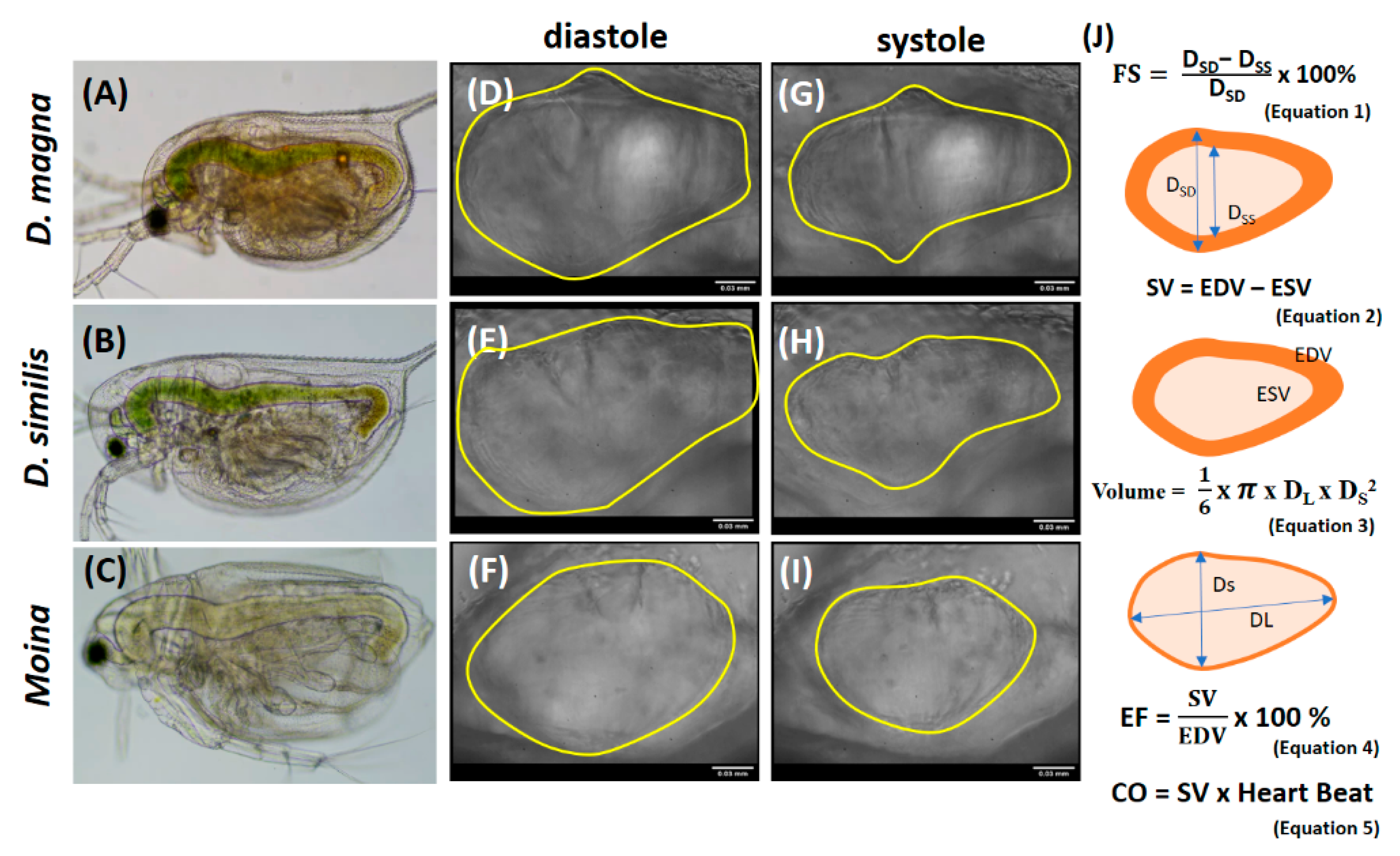
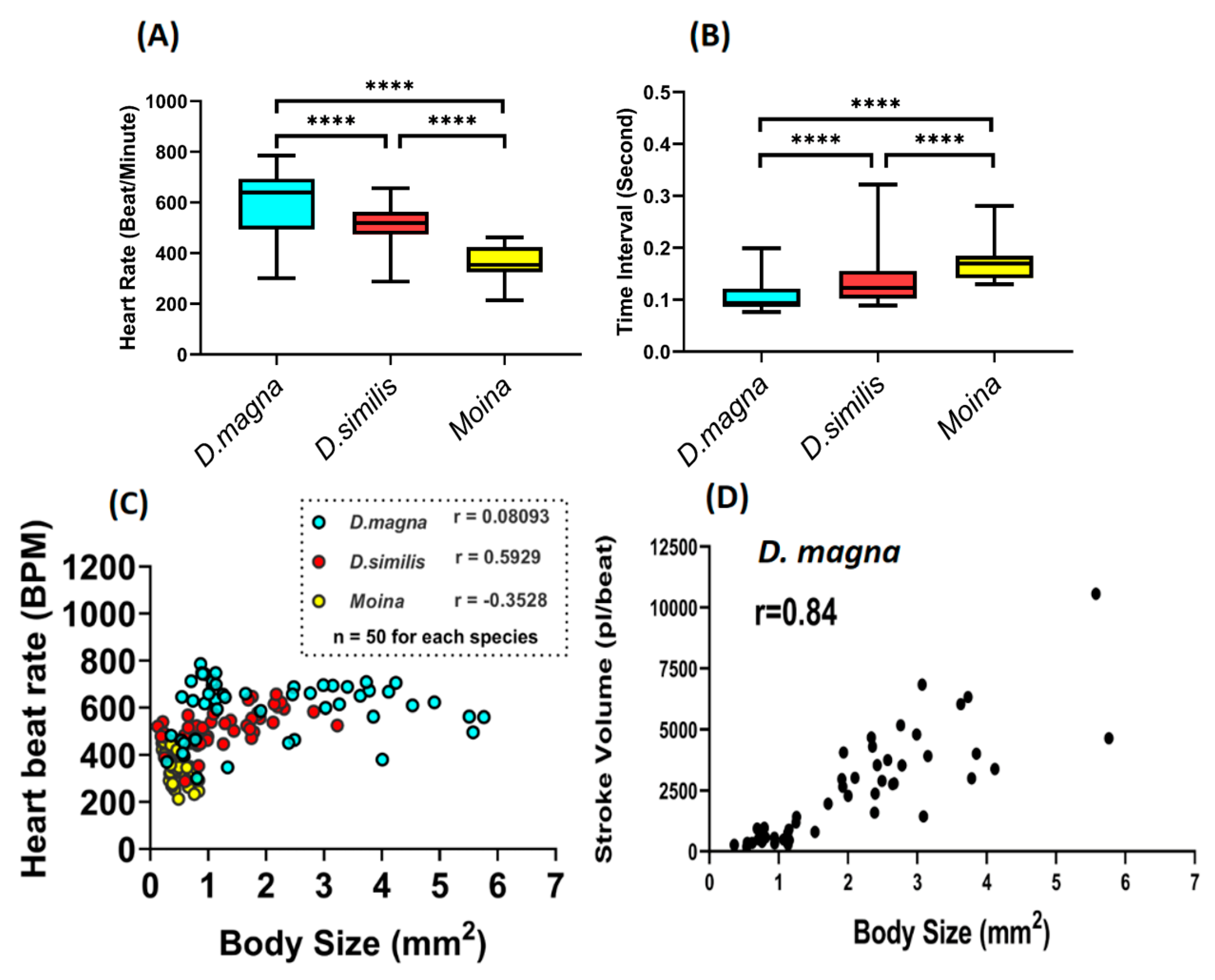
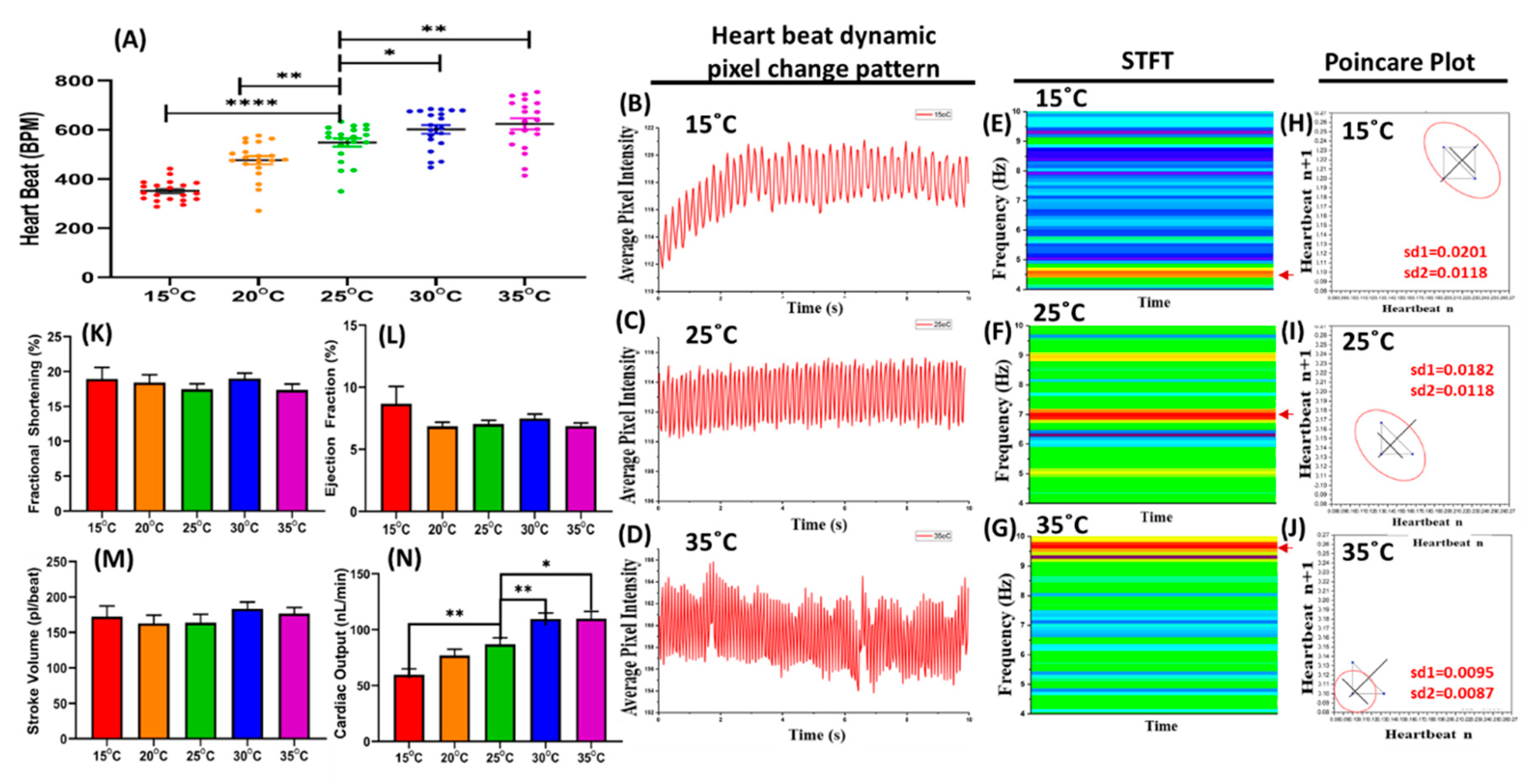


© 2020 by the authors. Licensee MDPI, Basel, Switzerland. This article is an open access article distributed under the terms and conditions of the Creative Commons Attribution (CC BY) license (http://creativecommons.org/licenses/by/4.0/).
Share and Cite
Santoso, F.; Krylov, V.V.; Castillo, A.L.; Saputra, F.; Chen, H.-M.; Lai, H.-T.; Hsiao, C.-D. Cardiovascular Performance Measurement in Water Fleas by Utilizing High-Speed Videography and ImageJ Software and Its Application for Pesticide Toxicity Assessment. Animals 2020, 10, 1587. https://doi.org/10.3390/ani10091587
Santoso F, Krylov VV, Castillo AL, Saputra F, Chen H-M, Lai H-T, Hsiao C-D. Cardiovascular Performance Measurement in Water Fleas by Utilizing High-Speed Videography and ImageJ Software and Its Application for Pesticide Toxicity Assessment. Animals. 2020; 10(9):1587. https://doi.org/10.3390/ani10091587
Chicago/Turabian StyleSantoso, Fiorency, Viacheslav V. Krylov, Agnes L. Castillo, Ferry Saputra, Hong-Ming Chen, Hong-Thih Lai, and Chung-Der Hsiao. 2020. "Cardiovascular Performance Measurement in Water Fleas by Utilizing High-Speed Videography and ImageJ Software and Its Application for Pesticide Toxicity Assessment" Animals 10, no. 9: 1587. https://doi.org/10.3390/ani10091587
APA StyleSantoso, F., Krylov, V. V., Castillo, A. L., Saputra, F., Chen, H.-M., Lai, H.-T., & Hsiao, C.-D. (2020). Cardiovascular Performance Measurement in Water Fleas by Utilizing High-Speed Videography and ImageJ Software and Its Application for Pesticide Toxicity Assessment. Animals, 10(9), 1587. https://doi.org/10.3390/ani10091587






